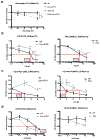Loss of Primary Cilia Drives Switching from Hedgehog to Ras/MAPK Pathway in Resistant Basal Cell Carcinoma
- PMID: 30707899
- PMCID: PMC6591089
- DOI: 10.1016/j.jid.2018.11.035
Loss of Primary Cilia Drives Switching from Hedgehog to Ras/MAPK Pathway in Resistant Basal Cell Carcinoma
Abstract
Basal cell carcinomas (BCCs) rely on Hedgehog (HH) pathway growth signal amplification by the microtubule-based organelle, the primary cilium. Despite naive tumor responsiveness to Smoothened inhibitors (Smoi), resistance in advanced tumors remains common. Although the resistant BCCs usually maintain HH pathway activation, squamous cell carcinomas with Ras/MAPK pathway activation also arise, and the molecular basis of tumor type and pathway selection are still obscure. Here, we identify the primary cilium as a critical determinant controlling tumor pathway switching. Strikingly, Smoothened inhibitor-resistant BCCs have an increased mutational load in ciliome genes, resulting in reduced primary cilia and HH pathway activation compared with naive or Gorlin syndrome patient BCCs. Gene set enrichment analysis of resistant BCCs with a low HH pathway signature showed increased Ras/MAPK pathway activation. Tissue analysis confirmed an inverse relationship between primary cilia presence and Ras/MAPK activation, and primary cilia removal in BCCs potentiated Ras/MAPK pathway activation. Moreover, activating Ras in HH-responsive cell lines conferred resistance to both canonical (vismodegib) and noncanonical (atypical protein kinase C and MRTF inhibitors) HH pathway inhibitors and conferred sensitivity to MAPK inhibitors. Our results provide insights into BCC treatment and identify the primary cilium as an important lineage gatekeeper, preventing HH-to-Ras/MAPK pathway switching.
Copyright © 2019 The Authors. Published by Elsevier Inc. All rights reserved.
Conflict of interest statement
Conflict of interest statement
The authors state no conflict of interest.
Figures




References
-
- Axelson M, Liu K, Jiang X, He K, Wang J, Zhao H, et al. U.S. Food and Drug Administration approval: vismodegib for recurrent, locally advanced, or metastatic basal cell carcinoma. Clin Cancer Res 2013;19(9):2289–93. - PubMed
Publication types
MeSH terms
Substances
Grants and funding
LinkOut - more resources
Full Text Sources
Medical
Molecular Biology Databases
Miscellaneous

